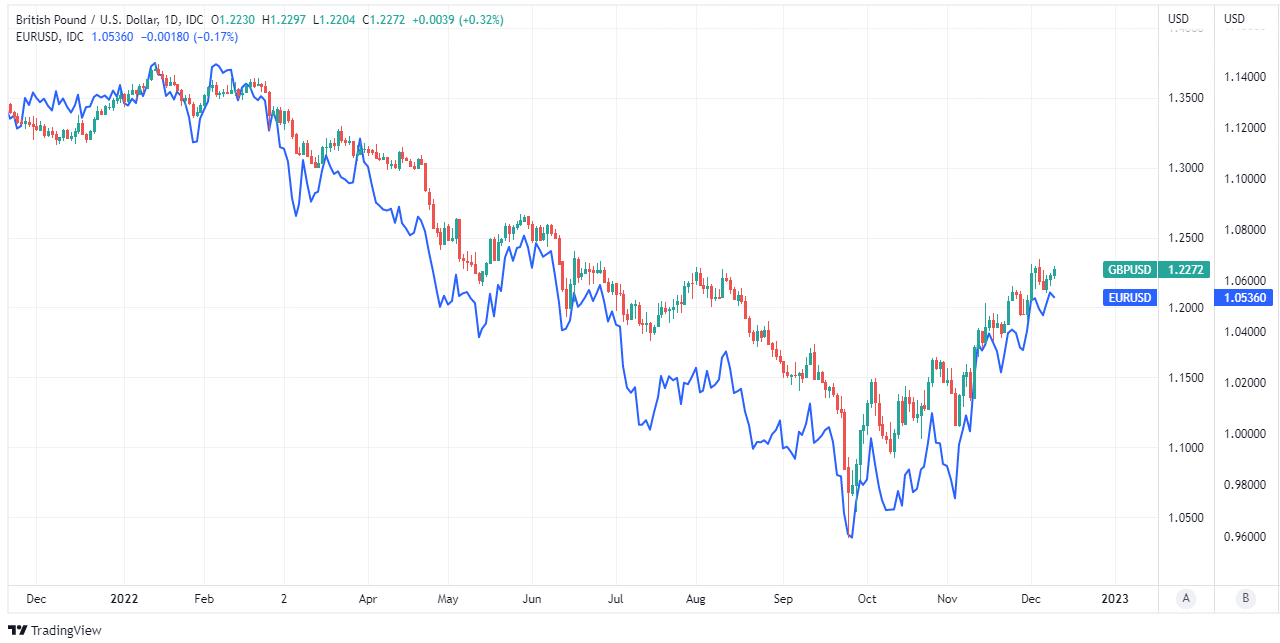GBP/USD Rate Stifled by Ominous Producer Price Inflation in U.S.
- Written by: James Skinner
-
"It is pretty straightforward that lower inflation should translate to a lower dollar" - BMO Capital Markets.

Image © Adobe Images
The Pound to Dollar exchange rate was knocked back from near the week's highs ahead of the weekend after U.S. producer prices rose further than was expected for November in what may be a warning of a protracted battle to get inflation back to the 2% target of the Federal Reserve (Fed).
Prices charged by producers of U.S. goods and services were expected to ease enough to pull down both monthly and annual inflation rates notably but on each count the declines came in smaller than was expected by economists.
PPI inflation was 0.3% in month-on-month terms and 7.4% for the year to the end of November, with both being higher than the 0.2% anticipated for last month and the 7.2% expected for the recent year.
Meanwhile, after removing energy and food producers from the data, the Core Producer Price Index figures left behind were also similarly problematic.
"On the face of it this is disappointing, given that we have been arguing for sometime that margins will re-compress, pulling down overall inflation. But almost half the November increase was in the fuels component, which is very volatile," says Ian Shepherdson, chief economist at Pantheon Macroeconomics.
Above: Pound to Dollar rate shown at 15-minute intervals alongside EUR/USD. Click image for closer inspection.
The Core Producer Price Index rose by 0.4% in November, up from 0.1% previously and above the 0.2% anticipated by economists while the annual rate of Core PPI inflation fell from 6.7% to only 6.2%, which is above the 5.9% envisaged by consensus.
Friday's data matters because it is potentially indicative of what can be expected from next week's consumer price inflation numbers but to the extent that this is the case, the figures might be more of a negative omen for Sterling in the short-term and a prospective stocking filler for the U.S. Dollar.
"PPI matters in that we will look to it for a preview of CPI. It should also matter because raw materials prices should, in theory, lead the prices of intermediate goods, which should lead the prices of consumer goods," says Stephen Gallo, European head of FX strategy at BMO Capital Markets.
"It is pretty straightforward that lower inflation should translate to a lower dollar. Lower inflation should bring risk-on in equities (which is bad for the USD) and lower US rates (also bad for the USD)," he adds in a Friday commentary.
Dollars were sold heavily throughout much of the last month and to the benefit of the Pound after consumer price inflation data suggested that U.S. price growth had fallen further than was expected in October, reinforcing market expectations for a slowdown in the pace of interest rate rises from the Fed.
Above: Pound to Dollar rate shown at hourly intervals alongside EUR/USD. Click image for closer inspection. If you are looking to protect or boost your international payment budget you could consider securing today's rate for use in the future, or set an order for your ideal rate when it is achieved, more information can be found here.
Above-target infation has prompted the Fed into one of its most aggressive monetary tightening processes on record, which is expected to see U.S. interest rates reach 4.75% or more by the early months of the New Year and next week's CPI inflation data for November will be important for determining just how high borrowing costs rise.
"For next week we have a lot of event risk to get through, and I imagine the only ones trading will be those that were brave enough to have some short term risk on into the events and those that 'have to' trade because of year-end," says Brad Bechtel, global head of FX at Jefferies.
"The mixed outlook on EMFX where Asia outperforms, Latam is mixed and Eastern Europe generally weaker, should help to keep the USD in a range over the course of the next few quarters. The US Fed ending their rate hiking cycle at a higher terminal than all the rest in the G10 will also underpin relative USD strength," he adds while writing in a Friday market commentary.
The danger with next week's data is of a partial rebound in inflation that could prompt financial markets to anticipate a higher peak for the Fed's interest rate and potentially stoke renewed appetite for the U.S. Dollar ahead of Wednesday's monetary policy decision.
Economists and analysts widely expect a half percentage point increase to take the Fed Funds rate up to 4.5% but far more important than the size of next Wednesday's move will be what the new Federal Open Market Committee forecasts suggest is likely to be the peak for borrowing costs.
Above: Pound to Dollar rate shown at daily intervals alongside EUR/USD. Click image for closer inspection. To optimise the timing of international payments you could consider setting a free FX rate alert here.














